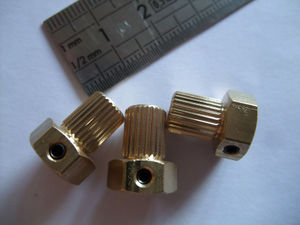This is not a definitive answer (and has turned into a ramble), as I have not yet had to change my filament size.
However, initially, I would have thought that only the hotend and the hotend's nozzle would need to be changed, from one that can handle the 1.75 mm filament to 3 mm. If the extruder is spring loaded, then it should adjust itself to the thicker filament, without a problem. If not, then you may have to do a slight manual adjustment.
However, after doing some further reading, there may be other factors that need to be considered, such as:
- Extruder gearing;
- Melt time (which would imply a different feed rate)
It could be worth having a close look at the aperture of your hotend. If, in the unlikely situation, it looks as if the hotend would accept 3 mm (or if you could remove the lining so that it can), you may not need to actually change any hardware, but instead just try tweeking the feedrate in the software, because as your nozzle is less than the width of the filament anyway, then it will be fine for both 1.75 mm and 3 mm. A 3 mm filament would require more heating, and therefore a slower feedrate than a 1.75 mm feedrate. Once the filament has melted, so long as the pressure from the extruder is sufficient, then the molten filament should come out of the nozzle. However, this may be a less than satisafctory method and result in some dubious prints.
There is an interesting thread on the RepRap wiki, 1.75mm Filament vs 3mm Filament, that discusses most of the points above.
It should be noted that the advantages of 3 mm filament has over 1.75 mm are that it is:
- cheaper
- stiffer (less flexible) and thus "easier" to push through the hotend.
As an aside, one interesting point raised in the thread, is that maybe a smaller extruder can be used, for the narrower 1.75 mm filament, thus resulting in a lighter print head. I am not sure how true that is.
This article, Converting a 3D printer from 3mm to 1.75mm, does the reverse of what you want, and comes with a video. It states that, as you have already found, that the hotend needs to be changed:
The printer [Thomas] is changing out to accept 1.75mm is the Lulzbot
Mini, one of the most popular printers that would ever need this
modification. The only required materials is a new hot end suitable
for 1.75mm filament, a 4mm drill, and a few wrenches and allen keys.
It would be a smart idea to get a hot end that uses the same
thermistor as the old one, but that’s not a deal-breaker as the
problem can be fixed in the firmware.
Alternatively, you could leave your printer as it is and use a 3mm to 1.75mm filament converter, which may be a bit of overkill for just one reel of filament1.
The bottomline
To be honest, is it worth the hassle, time and expense of having to modify and re-calibrate your printer (or worst case, change the model of the printer), just for the price of a reel of filament (assuming that you did not bulk purchase a bunch of reels)? It may be better to stick to one filament size (i.e. your original size) for all of your projects, and so resell the reel of 3 mm and stick with the 1.75 mm printer and buy the correct filament2.
1 See also Conversion of 3mm ABS filament to 1.75mm
2 See also Tom's answer to Conversion of 3mm ABS filament to 1.75mm
See also Can 1.75mm filament be used in a printer that takes 3mm filament?

